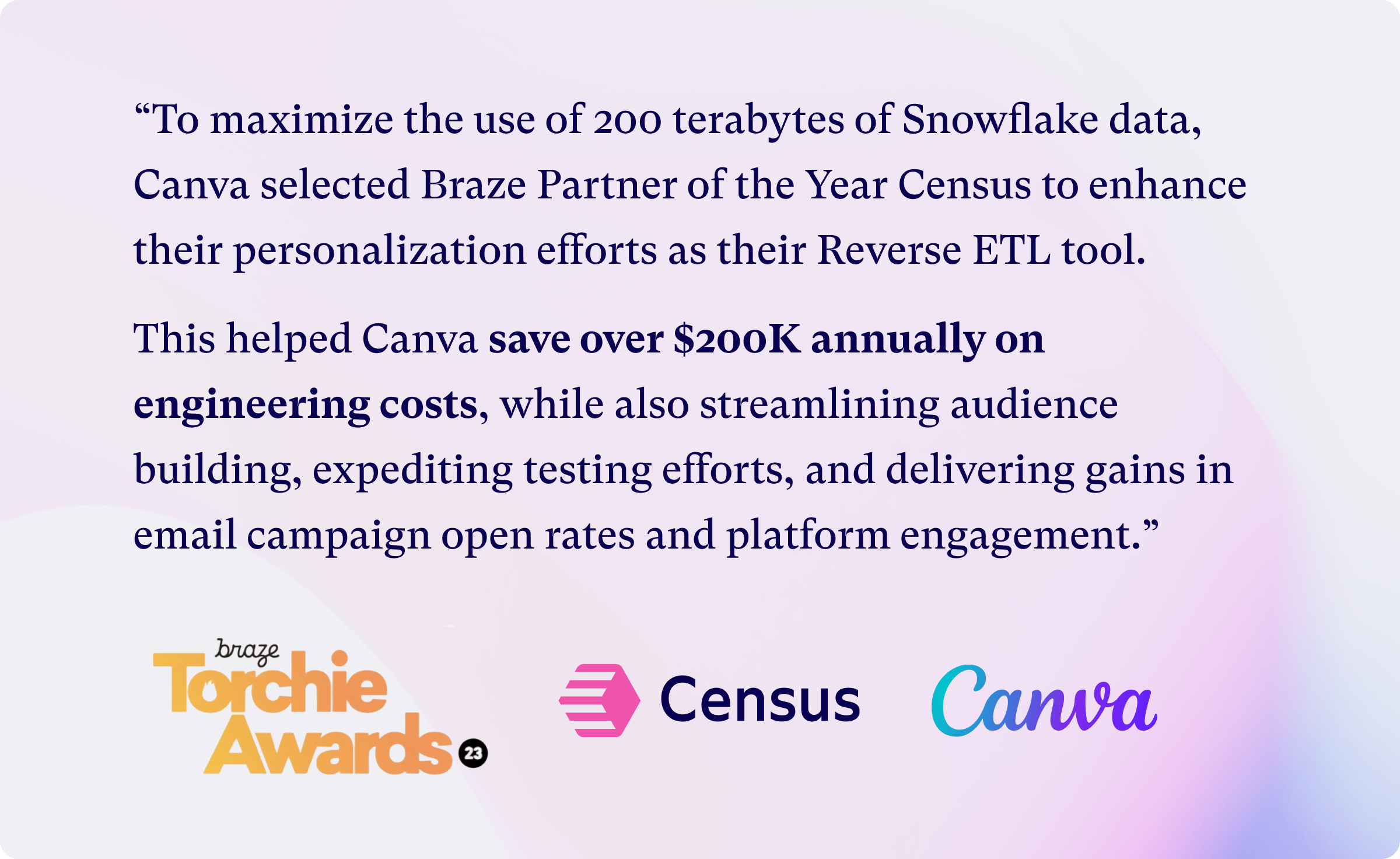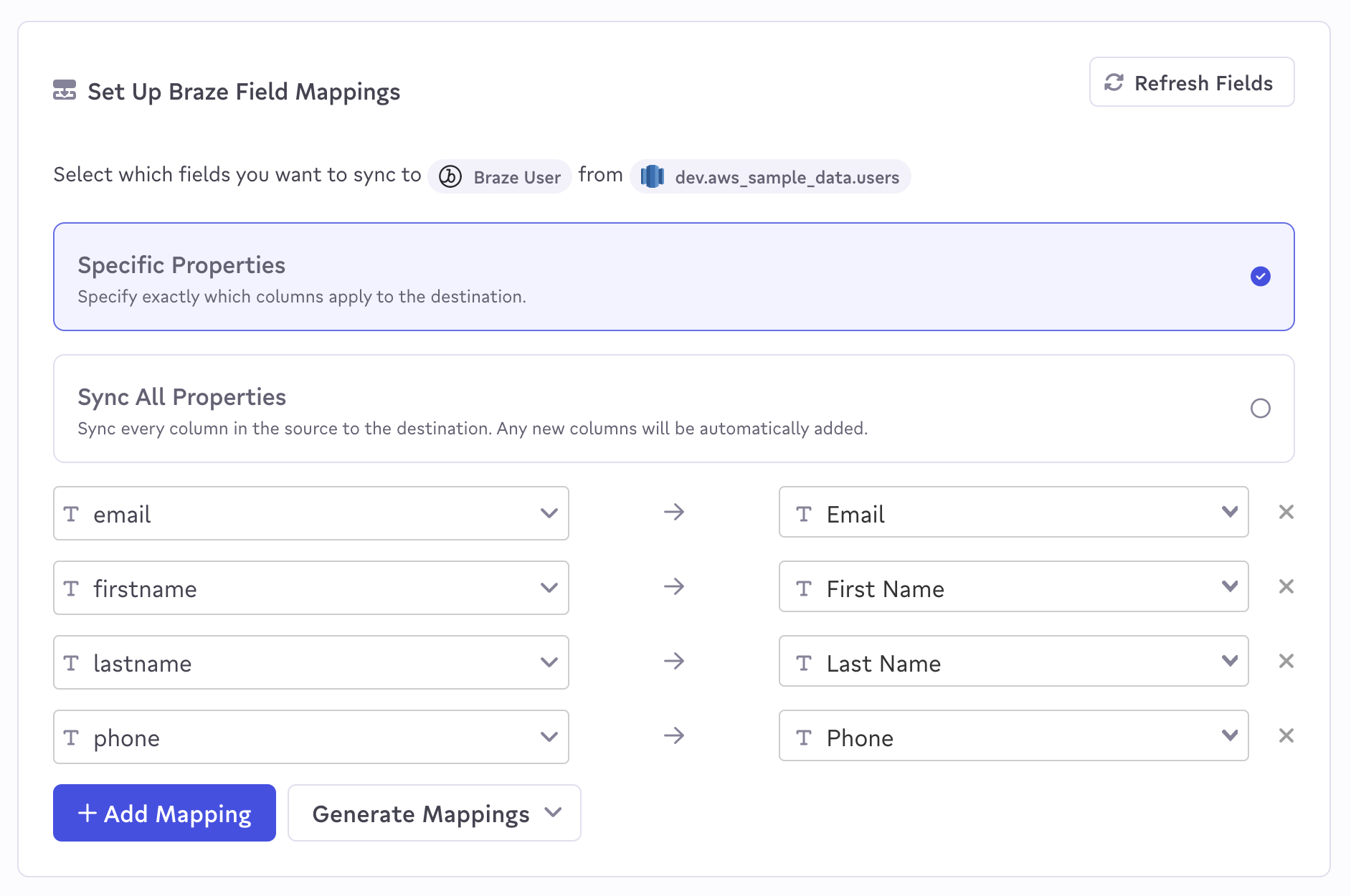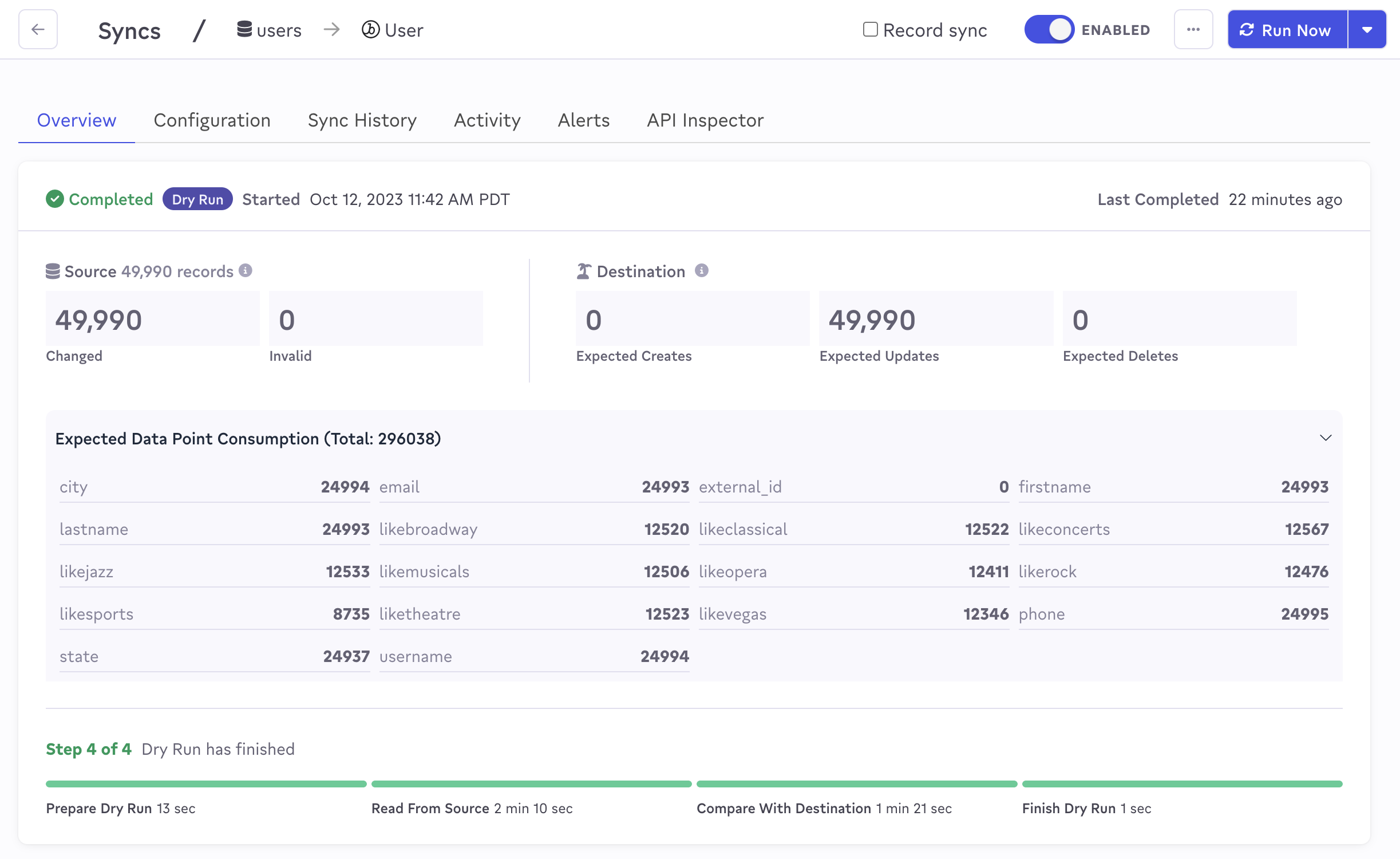The #1 Data Activation Partner for Braze
In today’s era of sky-high consumer expectations, marketers need to harness their customer data to target the right people with the right messages. Because real-time data is more important than ever to drive marketing outcomes, Braze recently named Census the 2023 Technology Partner of the Year.

Census is a best-in-class Data Activation platform that helps everyone access the data they need to take smarter, faster action.
Using Reverse ETL technology, we connect 360° customer data in the cloud data warehouse to over 200+ marketing and business tools, so you have a bird’s eye view of your customer wherever you work.
In this blog, I’ll walk you through why Census provides the industry’s best data integration for Braze.
3 Ways to Maximize Braze Value with Census
Census helps you maximize the value of Braze’s powerful customer engagement and cross-channel orchestration by powering Braze with fresh and trustworthy data.
According to global Braze agency Massive Rocket, connecting cloud data warehouses to Braze gets their customers up and running 3 times faster than before.
Adding Census on top of Snowflake, Databricks, BigQuery, or Redshift is the fastest way to harness customer insights and make them actionable in Braze.
Read more on the Braze blog: Activating Your Data Warehouse for Segmentation and Personalization
Let’s dive into three ways we enable you to leverage Braze to its fullest potential:
- Deep Integrations: Supercharging Braze with first-party data
- Cost Optimization: Forecasting Braze API costs
- Data Controls: Ensuring data security and governance
Deep Integrations: Supercharging Braze with first-party data
Your customers interact with your brand every day, like opening a push notification or replying to an email. Those valuable interactions are first-party data, aka customer data that your brand has collected firsthand.
First-party data is often stored in your cloud data warehouse and not easily accessible to marketers. This is where Census provides huge benefits to Braze users — helping you unlock customer understanding wherever it lives.
Braze was one of the first destinations we built a Reverse ETL integration for, and since 2018 we’ve maintained the fastest and most reliable data pipelines for Braze.
Census helps Braze customers:
1. Activate Real-Time Braze Journeys with the Data Warehouse
You can use Census to trigger a Braze Campaign or Canvas to enter a customer into a personalized journey. Uniquely, Census is the only warehouse-native platform that can even activate real-time journeys, like "abandoned cart" or "new signup" use cases that need to happen in seconds.
Normally, transactional or event-based use cases aren't possible in data warehouse architecture, but our new Census Live Syncs are the first to unlock data activation in real-time.
Even better, because Census sits on top of the complete Customer 360 in your warehouse, you can use any data as an API Trigger for Braze. Your API Trigger can be as simple as “product purchase” or as complex as “customer in the US spent more than $100 within 24 hours after signing up for our email newsletter.” If you can track it in your warehouse, you can use it — the sky’s the limit!

2. Sync your Complete Customer 360 to Braze User Profiles
You can use Census to easily enrich Braze User Profiles with first-party data from your warehouse, so you always have the customer information you need to build hyper-personalized experiences.
Our Reverse ETL interface enables you to map fields between your data source and destination (Braze objects), and update those fields automatically. We can sync your data in seconds (real-time), or on a set schedule such as hourly or daily. We minimize data point consumption in Braze by only updating field values that are different between Braze and your warehouse (more on this in the cost optimization section!).

3. Send Omnichannel Granular Audiences to Braze Cohorts
Census provides a no-code Audience Hub, purpose-built for marketers, that helps you create customer segments and publish them to Braze Cohorts. No CSV uploads or engineering favors needed!
Managing audiences upstream, in Census, makes it easy to create omnichannel campaigns consistent across multiple channels including ad platforms and lifecycle marketing tools like Braze. You define audiences once, on top of the warehouse, then use them everywhere in both owned and paid channels.

4. Sync Data to all the Braze Objects you need
Don’t let data prevent you from building campaigns and launching growth experiments! We support syncing data to all these objects and/or concepts in Braze to enable real-time personalization and journey orchestration:
- Events
- Users
- User Aliases
- Subscription Group Memberships
- Cohorts
- Catalogs
- API-Triggered Campaigns
- API-Triggered Canvas Entries
Read our Braze documentation for more information.
Cost Optimization: Forecasting Braze API costs
One huge advantage of using Census to power Braze is our ability to minimize data point consumption, and therefore optimize Braze costs. Braze has a unique pricing model where customers are charged per data point write, and Census’s unique architecture minimizes these by only syncing data points that have actually changed.
How we optimize Braze API costs:
- Census compares the mapped fields from Braze to the data in your warehouse or lakehouse. If there’s a change, Census will send that data point over from the source. If not, Census will not trigger a data point write.
- We compute these differences at a cell level, not just a row level, ensuring the maximum level of granularity for these data changes.
- When a record is deleted from a customer’s source data, we provide the option of two behaviors: delete the record in Braze or keep the record but null out all fields.
For instance, Canva saves $200K annually on engineering costs because Census enables Canva to aggregate events, set the frequency of syncs, and choose segments of users to send events for (instead of every user).
Braze Dry Runs: An Even Better Way to Predict API Costs
It can be daunting to sync large volumes of data or run large-scale campaigns when you’re not sure how your budget will be affected.
To help customers sync data with confidence, we’ve released a new feature called Braze Dry Runs that help you forecast API costs more transparently.
How Braze Dry Runs work:
When you set up a Census sync to Braze, you have the option to start a Dry Run. The Dry Run provides a preview of your sync without changing any data in your source or in Braze. You can quickly see the impact of your sync, with details such as:
- How many records did you have before and after the sync?
- How many records will be added and/or changed?
- How many "data point writes" will the sync cost you?

We believe this will help every customer maximize Braze usage and take full advantage of Braze’s powerful customer engagement tools, without being limited by data costs.
Data Controls: Ensuring data security and governance
As the leading Data Activation platform, Census is uniquely built for both marketing and data teams to collaborate and drive growth. We provide best-in-class marketing capabilities while also integrating with data security and governance workflows.
Marketers can rest assured that data in Braze is always trustworthy and up-to-date, and technical teams can easily set up data pipelines and alerts without manual maintenance.
In addition to Braze Dry Runs, Census provides enterprise-grade security and observability capabilities that make it simple to ensure governance and compliance. These capabilities come out-of-the-box and include:
- Version control and configuration as code with a Git integration
- Enterprise-grade access controls and workspace management
- Integrations with dbt, Looker, and Sigma models
- Sync and segment logs written back to the warehouse
- Alerting and monitoring with DataDog, PagerDuty, and Opsgenie
- Orchestration with Airflow, Prefect, Dagster, Airbyte, and Fivetran sync triggers
- Live API Inspector
- GDPR, HIPAA, and Soc 2 Type II compliance
Census integrates seamlessly with existing data infrastructure so data teams can add Census to their stack and immediately see business value, without compromising their workflows.
Conclusion
At Census, we firmly believe that brands who fully leverage their first-party data will outperform their competitors. More and more, enterprises will look to transform their cloud data warehouses into growth engines to keep up with rapid shifts in privacy, AI, and marketing technology.
As Braze’s top Data Activation partner, we’d love to help you unify your data and marketing to maximize the value of real-time personalization and engagement in Braze.
Get a customized onboarding of Census or start a free trial today!

















